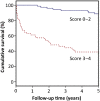Cystatin C in a composite risk score for mortality in patients with infective endocarditis: a cohort study
- PMID: 22798251
- PMCID: PMC3400063
- DOI: 10.1136/bmjopen-2012-000856
Cystatin C in a composite risk score for mortality in patients with infective endocarditis: a cohort study
Abstract
Objective: To develop a multimarker prognostic score for infective endocarditis (IE).
Design: Retrospective case-control.
Setting: Secondary care. Single centre.
Participants: 125 patients with definite IE.
Primary outcome measures: 90-day and 5-year mortality.
Results: Mean age was 62.7±17 years. The 90-day and 5-year mortality was 10.4% and 33.6%, respectively. CysC levels at admission and over 20% increases in CysC levels during 2 weeks of treatment were prognostic for 90-day and 5-year mortality independent of creatinine estimated glomerular filtration rate. In multivariate analyses, CysC (OR 5.42, 95% CI 1.90 to 15.5, p=0.002) and age (OR 1.06, 95% CI 1.02 to 1.10, p=0.002) remained prognostic for 5-year mortality. NT-proBNP, TnT, C reactive protein and interleukin 6 were also linked to prognosis. A composite risk scoring system using levels of CysC, NT-proBNP, age and presence of mitral valve insufficiency was able to separate a high-risk and a low-risk group.
Conclusions: CysC levels at admission and increase in CysC after 2 weeks of treatment were independent prognostic markers for both 90-day and 5-year mortality in patients with IE. A multimarker composite risk scoring system including CysC identified a high-risk group.
Conflict of interest statement
Figures


Similar articles
-
Heart failure mortality according to acute variations in N-terminal pro B-type natriuretic peptide and cystatin C levels.J Cardiovasc Med (Hagerstown). 2014 Feb;15(2):115-21. doi: 10.2459/JCM.0b013e3283654bab. J Cardiovasc Med (Hagerstown). 2014. PMID: 24522084
-
Prognostic Value of Cystatin C-Derived Estimated Glomerular Filtration Rate in Patients with Acute Heart Failure.Cardiorenal Med. 2020;10(4):232-242. doi: 10.1159/000504084. Epub 2020 Apr 21. Cardiorenal Med. 2020. PMID: 32316021
-
Multimarker approach with cystatin C, N-terminal pro-brain natriuretic peptide, C-reactive protein and red blood cell distribution width in risk stratification of patients with acute coronary syndromes.Rev Port Cardiol. 2014 Mar;33(3):127-36. doi: 10.1016/j.repc.2013.09.013. Epub 2014 Mar 24. Rev Port Cardiol. 2014. PMID: 24674467
-
Estimating renal function in children: a new GFR-model based on serum cystatin C and body cell mass.Dan Med J. 2012 Jul;59(7):B4486. Dan Med J. 2012. PMID: 22759853 Review.
-
Cystatin C: an improved estimator of glomerular filtration rate?Clin Chem. 2002 May;48(5):699-707. Clin Chem. 2002. PMID: 11978596 Review.
Cited by
-
The impact of thrombocytopenia on mortality in infective endocarditis - a meta-analysis.Int J Cardiol Heart Vasc. 2025 Aug 5;60:101760. doi: 10.1016/j.ijcha.2025.101760. eCollection 2025 Oct. Int J Cardiol Heart Vasc. 2025. PMID: 40809447 Free PMC article. Review.
-
Exploring the Risk Factors and Possible Role of Calcium in Infective Endocarditis.Diagnostics (Basel). 2023 Jul 17;13(14):2386. doi: 10.3390/diagnostics13142386. Diagnostics (Basel). 2023. PMID: 37510130 Free PMC article. Review.
-
Infective endocarditis risk scores: a narrative review.J Thorac Dis. 2025 Apr 30;17(4):2662-2678. doi: 10.21037/jtd-2024-2041. Epub 2025 Apr 27. J Thorac Dis. 2025. PMID: 40400946 Free PMC article. Review.
-
Infective endocarditis: Do we have an effective risk score model? A systematic review.Front Cardiovasc Med. 2023 Feb 20;10:1093363. doi: 10.3389/fcvm.2023.1093363. eCollection 2023. Front Cardiovasc Med. 2023. PMID: 36891243 Free PMC article.
-
Perioperative risk stratification scores in infective endocarditis and its usefulness.Indian J Thorac Cardiovasc Surg. 2024 May;40(Suppl 1):47-60. doi: 10.1007/s12055-023-01644-y. Epub 2023 Dec 18. Indian J Thorac Cardiovasc Surg. 2024. PMID: 38827549 Free PMC article. Review.
References
-
- Tleyjeh IM, Steckelberg JM, Murad HS, et al. Temporal trends in infective endocarditis: a population-based study in Olmsted County, Minnesota. JAMA 2005;293:3022–8 - PubMed
-
- Thuny F, Di Salvo G, Belliard O, et al. Risk of embolism and death in infective endocarditis: prognostic value of echocardiography: a prospective multicenter study. Circulation 2005;112:69–75 - PubMed
-
- Thuny F, Avierinos JF, Tribouilloy C, et al. Impact of cerebrovascular complications on mortality and neurologic outcome during infective endocarditis: a prospective multicentre study. Eur Heart J 2007;28:1155–61 - PubMed
-
- Sambola A, Fernandez-Hidalgo N, Almirante B, et al. Sex differences in native-valve infective endocarditis in a single tertiary-care hospital. Am J Cardiol 2010;106:92–8 - PubMed
LinkOut - more resources
Full Text Sources
Research Materials
